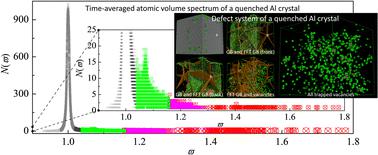当前位置:
X-MOL 学术
›
Mater. Horiz.
›
论文详情
Our official English website, www.x-mol.net, welcomes your feedback! (Note: you will need to create a separate account there.)
Time-averaged atomic volume spectrum: locating and identifying vacancies
Materials Horizons ( IF 13.3 ) Pub Date : 2024-04-03 , DOI: 10.1039/d4mh00140k YongQuan Wu 1 , Hao Wang 1 , JiaHao Fu 1 , BoYang Zhang 1 , Xu Zhao 1 , Kai Zhang 1
Materials Horizons ( IF 13.3 ) Pub Date : 2024-04-03 , DOI: 10.1039/d4mh00140k YongQuan Wu 1 , Hao Wang 1 , JiaHao Fu 1 , BoYang Zhang 1 , Xu Zhao 1 , Kai Zhang 1
Affiliation

|
Vacancies, as well as their derivatives, usually play a crucial role in many essential properties of materials. However, they always behave erratically, especially under universal thermal vibration, and are therefore difficult to accurately locate. Until now, the lack of an accurate and flexible method for locating and identifying vacancies has hampered the development of relative fields. In this paper, we present a new method to solve this problem. The strategy is to target the atomic cage enwrapping vacancies instead of the vacancies themselves. The core of the method is a time-averaged atomic volume spectrum (TAVS). The key to this method is to identify atoms using time-averaged rather than transient atomic volume, thereby simultaneously denoising intrinsic thermal vibration and avoiding vacancy migration jump. Using this method, we have succeeded for the first time in obtaining the panoramic maps of spontaneously trapped defects in quenched and annealed face-centered cubic aluminum and even the instantaneous images of a steady trapping process. All characteristics of each trapped vacancy, including location, dimension, volume and morphology, as well as aggregate statistical data such as vacancy amount and concentration, can be completely and accurately obtained. Furthermore, these first maps of defects (vacancies) revealed some surprising and interesting phenomena for future exploration. In conclusion, this method provides not only a means of locating and catching vacancies, but also a strategy for identifying and characterizing vacancies. On the basis of its successful application in FCC Al, the TAVS method can be easily extended to other systems as well.
中文翻译:

时间平均原子体积谱:定位和识别空位
空位及其衍生物通常在材料的许多基本性能中发挥着至关重要的作用。然而,它们总是表现得不稳定,特别是在普遍的热振动下,因此很难准确定位。迄今为止,缺乏准确、灵活的职位空缺定位和识别方法,阻碍了相关领域的发展。在本文中,我们提出了一种新方法来解决这个问题。该策略是针对包裹空位的原子笼,而不是空位本身。该方法的核心是时间平均原子体积谱(TAVS)。该方法的关键是使用时间平均而不是瞬态原子体积来识别原子,从而同时对固有热振动进行降噪并避免空位迁移跳跃。利用这种方法,我们首次成功获得了淬火和退火面心立方铝中自发捕获缺陷的全景图,甚至是稳定捕获过程的瞬时图像。可以完整、准确地获得每个捕获空位的所有特征,包括位置、尺寸、体积和形态,以及空位数量和浓度等聚合统计数据。此外,这些第一张缺陷(空位)图揭示了一些令人惊讶和有趣的现象,可供未来探索。总之,该方法不仅提供了定位和捕捉职位空缺的手段,而且提供了识别和描述职位空缺的策略。基于在 FCC Al 中的成功应用,TAVS 方法也可以轻松扩展到其他系统。
更新日期:2024-04-03
中文翻译:

时间平均原子体积谱:定位和识别空位
空位及其衍生物通常在材料的许多基本性能中发挥着至关重要的作用。然而,它们总是表现得不稳定,特别是在普遍的热振动下,因此很难准确定位。迄今为止,缺乏准确、灵活的职位空缺定位和识别方法,阻碍了相关领域的发展。在本文中,我们提出了一种新方法来解决这个问题。该策略是针对包裹空位的原子笼,而不是空位本身。该方法的核心是时间平均原子体积谱(TAVS)。该方法的关键是使用时间平均而不是瞬态原子体积来识别原子,从而同时对固有热振动进行降噪并避免空位迁移跳跃。利用这种方法,我们首次成功获得了淬火和退火面心立方铝中自发捕获缺陷的全景图,甚至是稳定捕获过程的瞬时图像。可以完整、准确地获得每个捕获空位的所有特征,包括位置、尺寸、体积和形态,以及空位数量和浓度等聚合统计数据。此外,这些第一张缺陷(空位)图揭示了一些令人惊讶和有趣的现象,可供未来探索。总之,该方法不仅提供了定位和捕捉职位空缺的手段,而且提供了识别和描述职位空缺的策略。基于在 FCC Al 中的成功应用,TAVS 方法也可以轻松扩展到其他系统。



























 京公网安备 11010802027423号
京公网安备 11010802027423号